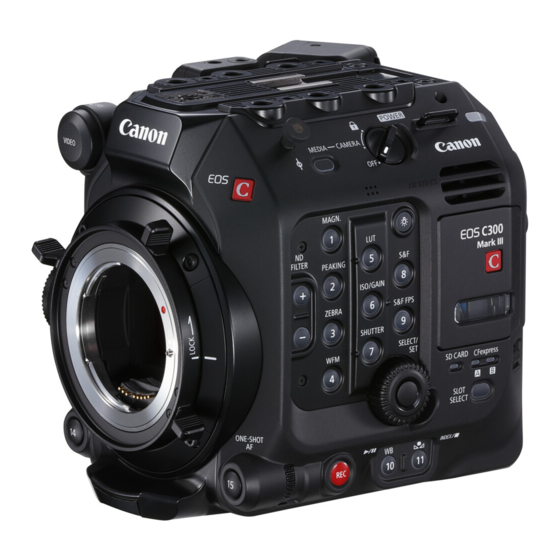
Canon CINEMA EOS C300 Quick Start Manual
For 2k and hd origination
Hide thumbs
Also See for CINEMA EOS C300:
- Instruction manual (202 pages) ,
- Brochure & specs (11 pages) ,
- User manual (2 pages)
Summary of Contents for Canon CINEMA EOS C300
- Page 1 WHITE PAPER EOS C300 / EOS C500 CINEMA EOS FOR 2K AND HD ORIGINATION Written by Larry Thorpe Professional Engineering & Solutions Division, Canon U.S.A., Inc. For more info: cinemaeos.usa.canon.com © 2013 Canon USA, Inc. All rights reserved.
- Page 2 Cinema EOS for 2K and HD Origination Introduction Canon began a rollout of a family of Cinema EOS cameras in the Fall of 2011. The EOS C300 made its debut in November 2011 as an HD-only camera that captured digital HD in-camera to Compact Flash cards.
- Page 3 Most large-format single-sensor cameras employs the Bayer CFA (color filter array) to encode the RGB color information. Typically, the RAW outputs from these cameras constitute a single output signal which is subsequently debayered to structure the three separate RGB video components. This process entails some degree of reconstruction errors depending upon the sophistication of the debayering algorithm.
- Page 4 In-Camera Recording in the EOS C500 and C300 Both camera employ identical in-camera recording capabilities. They both deploy an MPEG-2 codec to do this recording. Figure 3 Summarizing the salient features of the in-camera recording within the C500 and C300 More specific details of the in-camera recording are summarized in table 2.
- Page 5 EOS C500 as High performance 2K or HD Acquisition System Where the C300 is intended as a compact camcorder with on board MPEG-2 recording, the C500 is intended to originate considerably higher performance 2K or HD digital component video which is then captured on a broad choice of world renowned external digital recorders.
- Page 6 10-bit YUV 4:2:2 and this component set can be originated as high as 120 progressive fps (selectable in 2-frame steps from 62 to 120 fps as shown in Table 4). 8. Canon Log [4] is applied to each of the RGB components which are then delivered as 12-bit RAW components for recording.
- Page 7 Motion Imaging”. Canon White Paper: “Sensitometric Characteristics of the EOS C300 Digital Cine Camera” Canon White Paper: “Canon-Log Cine Optoelectronic Transfer Function” All of these listed White Papers can be found on the Canon website via the following URL: http://www.learn.usa.canon.com/resources/artices/2012/cinemaeos_white_papers.shtml...













